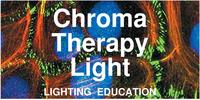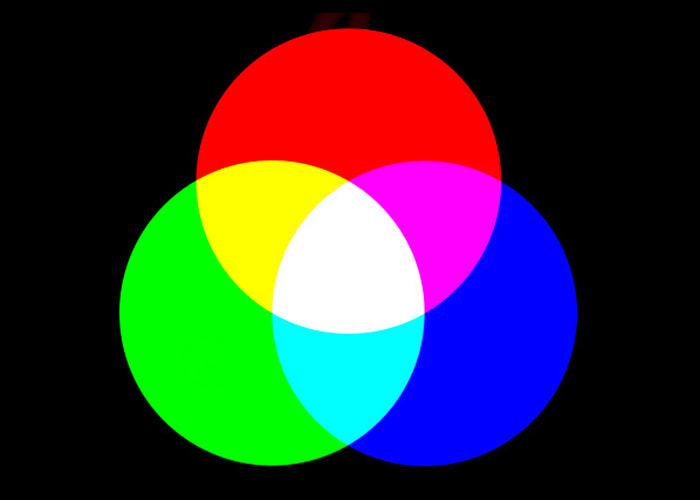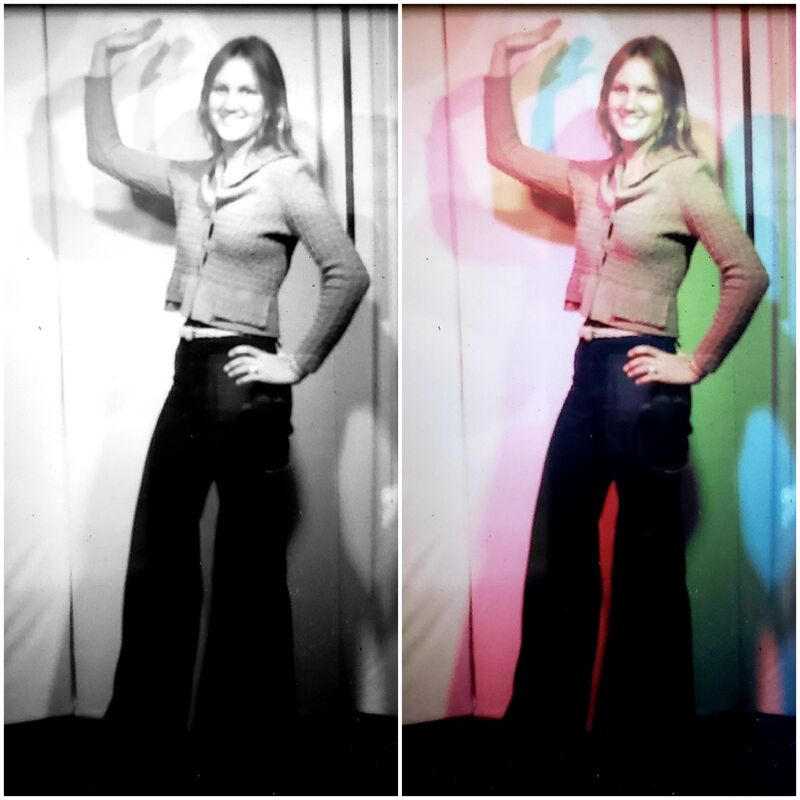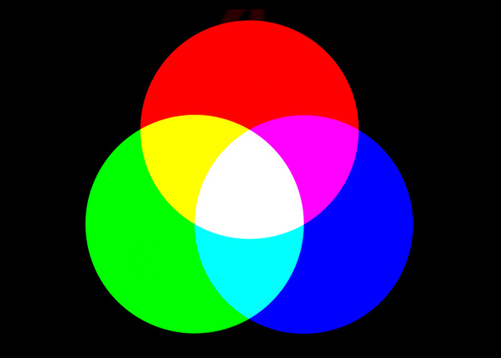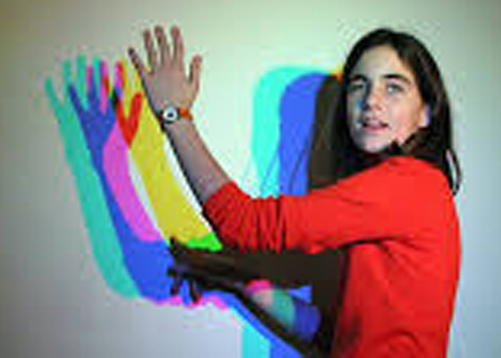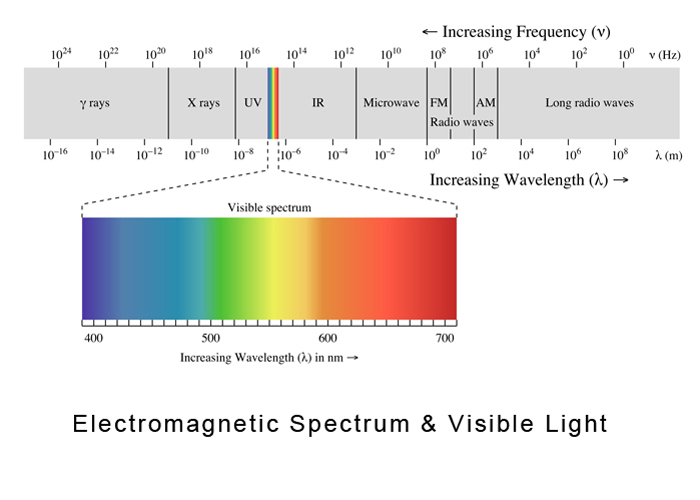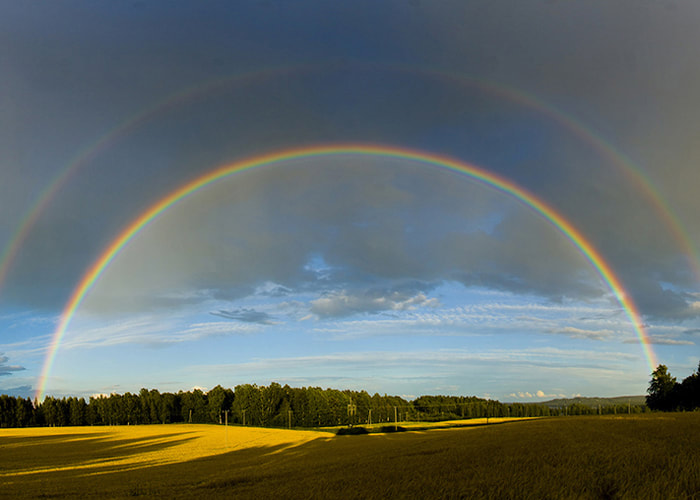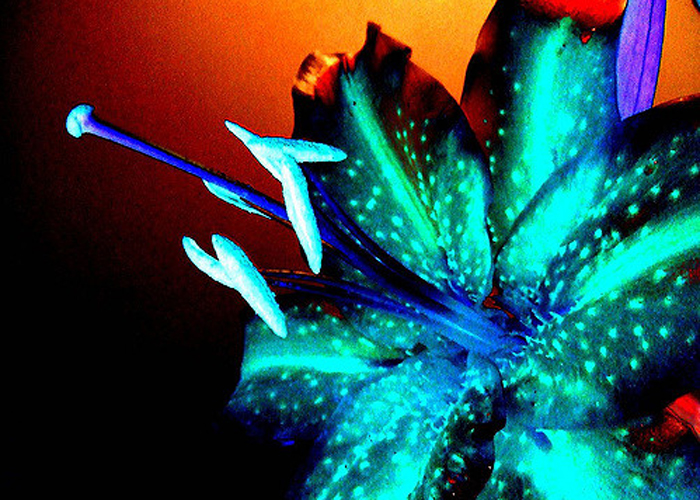Learning Objectives
Color in Light
Combine all colors in light and you get white or combine any three colors equidistant on the color wheel to produce white light, usually red + green + blue producing magenta, turquoise, and yellow shadows.
To see a color the wavelength must be in the light source. When you see color, you are seeing wavelengths reflected back to you, the rest of the colors are being absorbed by the surface. Why isn't brown in the spectrum? Because brown is the combination of many colors both in light and paint. How we measure color in light? A part of the Electromagnetic Spectrum called Visible Light is measured in nanometers, nm. This information is useful when understanding the color rendering ability and color bias of various light sources when compared to daylight. The primary colors in light; red + blue-violet + green combine to make white light. The shadows in pure color light make the complimentary colors, found opposite on the color wheel, magenta, turquoise, yellow. Tri colors forming white light.
Complimentary Shadows
This photo below illustrates how complimentary shadows can be seen in color when a three primary light colors from white light, shining from different angles. Notice the light on her face shows natural color illuminated with white light; however, the shadows are bright Turquoise, Magenta, and Yellow, the secondary colors in light.
The difficulty in performing this experiment is finding pure primary light sources, in the old days we used dicro PAR lamps, or theatrical filters, today we can use Monocrhomatic or tunable LED sources for the red, blue, and green lights. Combine all colors in light and you get white or any three colors equidistant on the color wheel will produce white light, usually red + green + blue. What Wavelength Goes With a Color?
Our eyes are sensitive to light which lies in a very small region of the electromagnetic spectrum labeled 'visible light.' This visible light corresponds to a wavelength range of 400 - 700 nanometers (nm,) a color range of violet through red. The human eye is not capable of "seeing" radiation with wavelengths outside the visible spectrum although some animals and insects can. The visible colors from shortest to longest wavelength are: violet, blue, green, yellow, orange, and red. Ultraviolet radiation has a shorter wavelength than the visible violet light. Infrared radiation has a longer wavelength than visible red light. The white light is a mixture of the colors of the visible spectrum. Black is a total absence of light.
Why isn't brown in the spectrum? Brown is a mixture of colors. Depending on the light source all colors shift in appearance; however, neutral colors such as brown, beige, and grey shift even more noticeably, since they are a combination of colors. See Color Phenomena for activating a neutral another way colors appear to 'shift.' Earth's most important energy source is the Sun. Sunlight consists of the entire electromagnetic spectrum. [1] Sunlight is the basis for color comparisons of light sources, measured as Color Rendering Index (CRI) sunlight having a CRI of 100. Sunset colors are particles in the atmosphere capturing and reflecting light.
To understand why this is so, one need only recall how typical sky colors are produced. The familiar blue of the daytime sky is the result of the selective scattering of sunlight by air molecules. Scattering is the scientific term used to describe the reflection or re-direction of light by small particles .... At sunrise or sunset, sunlight takes a much longer path through the atmosphere than during the middle part of the day. Because this lengthened path results in an increased amount of violet and blue light being scattered out of the beam by the nearly infinite number of scattering "events" that occur along the way (a process collectively known as multiple scattering), the light that reaches an observer early or late in the day is noticeably reddened. Thus, it could be said that sunsets are red because the daytime sky is blue. [1]
|
Electromagnetic Spectrum & Visible LightVisible light is only part of the Electromagnetic Spectrum surrounding us, X rays;, Ultra Violet Light, UV, Visible Light, Infa Red Light, Microwaves, Radio Waves, and Long waves.
Visible Spectrum
390 to 700 Nanometers, nm, describes the wavelengths visible to the human eye.
RainbowsIf you are looking for a rainbow, turn your back to the sun at the end of a rainstorm. Particles in the sky, droplets of moisture, split the sunlight in the same way a prism will, creating distinct bands of color. Each water droplet acts like a tiny prism. Light is refracted upon entering the droplet, then reflected onto the back of the droplet, then refracted a second time upon exiting the droplet.
A double rainbow forms when light is reflected twice on the inside of the droplet. Color Vision in Insects and animals
Animals have vision that differs from humans, bees and butterflies see colors we cannot see, more Ultra Violet wavelengths, guiding them to the patterns in flowers. Dogs and cats mostly see."... greys and some blues and yellows." [3]
"... In general, humans can see wavelengths of the electromagnetic spectrum from 400 to 800 nanometers - from violet to red. Insects, on the other hand, perceive wavelengths of from 650 to 300 nanometers, including the ultraviolet range of the spectrum. " [4] Circadian Animals Footnotes
Photo Credits
|
- Home
-
- CHROMA Topics
- Color Spectrum - Light is Energy
- Color in Light
- Color in Nature
- Color in Paint
- Why does paint fade?
- Color Names & Meanings
- Color Phenomena
- Color Perception is Individual
- Color In Fashion
- Color for your home
- Color in Space
- Color Blindness
- Color Blind Interview
- Synesthesia
- Synesthete Deborah Borrowdale-Cox
- Synesthete Stephen Orr, BH&G Editor
-
- Circadian & THERAPY Topics
- Circadian Explained
- Circadian Ganglion Cells
- Circadian Melatonin
- Circadian Animals
- Circadian Research
- Autism & Lighting for the Spectrum
- Blue Light Dimming Apps
- Red Night Lights
- Vitamin D & Light
- SAD - Seasonal Affective Disorder
- Alzheimers and Light Therapy
- Photosensitivity - Light Sensitive Drugs
- Red Light Therapy
- Sleep & Lighting
- Dreams and Second Sleep
- NASA - Lighting in Space & Undersea
- Jet Lag
- Sunglasses
- Chakras
- Crystals, Minerals, & Gemstones
-
- LIGHTing Design Topics
- UV Germicidal Disinfection Light
- LED Lighting Facts Card
- CRI - Color Rendering Index
- LED TM-30
- LED Kelvin Color
- LED LPW
- LED Flicker
- LED Glare
- OLED - Organic LED
- Human Centric Lighting
- Lighting with Daylighting
- Lighting for Healthy Buildings & Zero Net Energy
- Lighting for Healthcare
- Lighting for Horticulture
- Lighting for Hospitality & LED Retrofits
- Lighting for Museums
- Lighting for Seniors & Low Vision
- Lighting Design Tips & Codes
- Parking Lot Lighting
- Solar Lighting for Humanity & World Health
- Davis Insectary Garden
- Santa Barbara Mesa Insectary Garden
- Home
-
- CHROMA Topics
- Color Spectrum - Light is Energy
- Color in Light
- Color in Nature
- Color in Paint
- Why does paint fade?
- Color Names & Meanings
- Color Phenomena
- Color Perception is Individual
- Color In Fashion
- Color for your home
- Color in Space
- Color Blindness
- Color Blind Interview
- Synesthesia
- Synesthete Deborah Borrowdale-Cox
- Synesthete Stephen Orr, BH&G Editor
-
- Circadian & THERAPY Topics
- Circadian Explained
- Circadian Ganglion Cells
- Circadian Melatonin
- Circadian Animals
- Circadian Research
- Autism & Lighting for the Spectrum
- Blue Light Dimming Apps
- Red Night Lights
- Vitamin D & Light
- SAD - Seasonal Affective Disorder
- Alzheimers and Light Therapy
- Photosensitivity - Light Sensitive Drugs
- Red Light Therapy
- Sleep & Lighting
- Dreams and Second Sleep
- NASA - Lighting in Space & Undersea
- Jet Lag
- Sunglasses
- Chakras
- Crystals, Minerals, & Gemstones
-
- LIGHTing Design Topics
- UV Germicidal Disinfection Light
- LED Lighting Facts Card
- CRI - Color Rendering Index
- LED TM-30
- LED Kelvin Color
- LED LPW
- LED Flicker
- LED Glare
- OLED - Organic LED
- Human Centric Lighting
- Lighting with Daylighting
- Lighting for Healthy Buildings & Zero Net Energy
- Lighting for Healthcare
- Lighting for Horticulture
- Lighting for Hospitality & LED Retrofits
- Lighting for Museums
- Lighting for Seniors & Low Vision
- Lighting Design Tips & Codes
- Parking Lot Lighting
- Solar Lighting for Humanity & World Health
- Davis Insectary Garden
- Santa Barbara Mesa Insectary Garden
